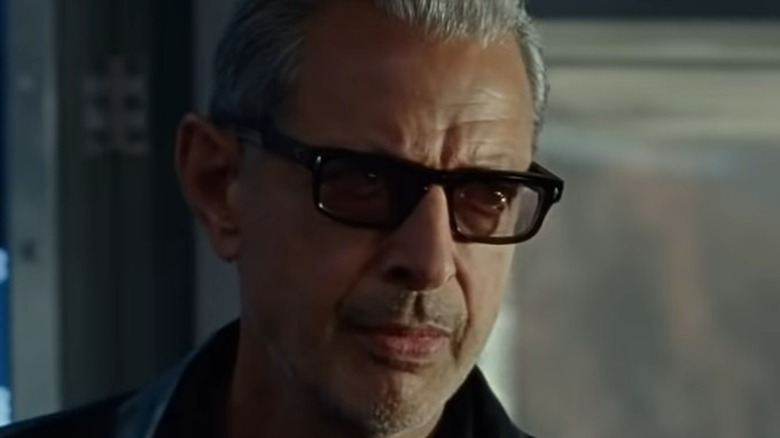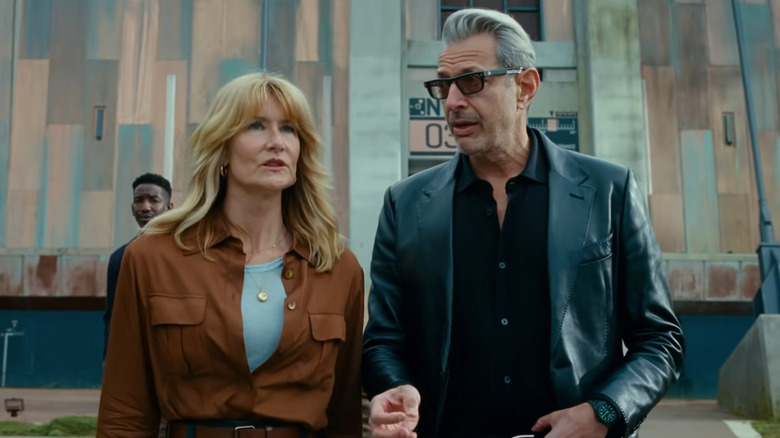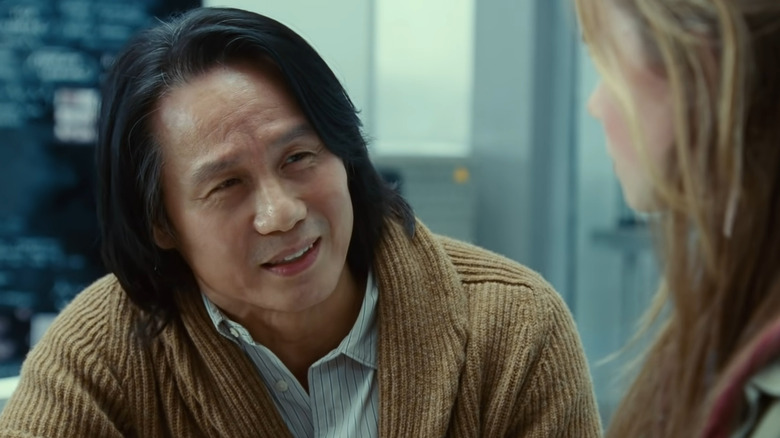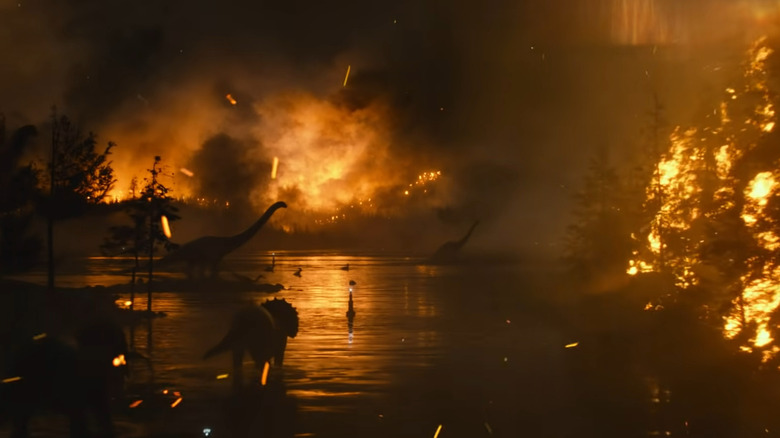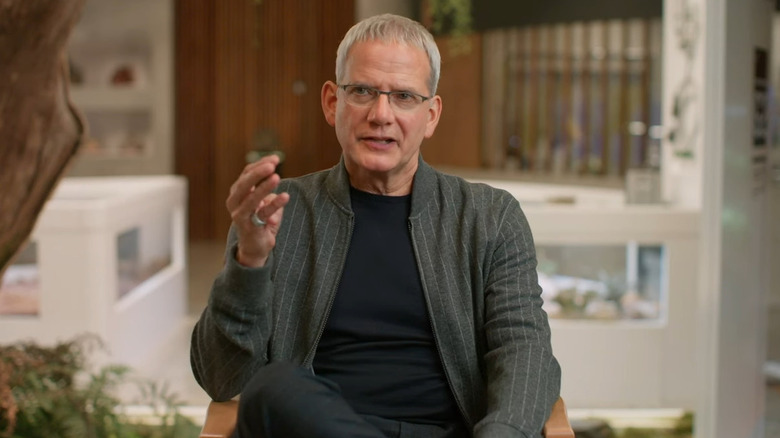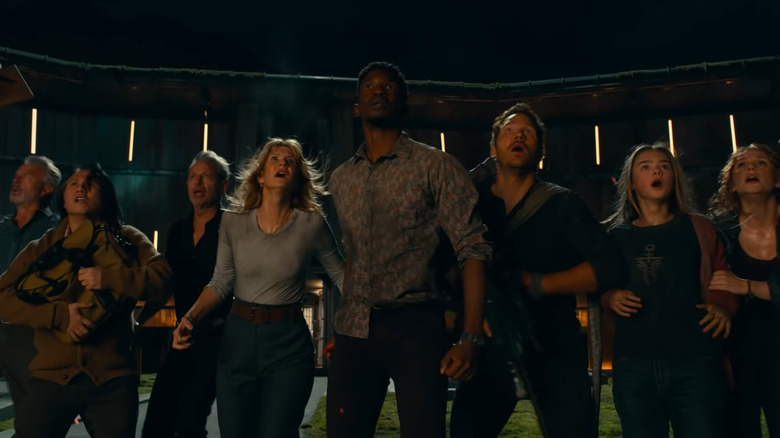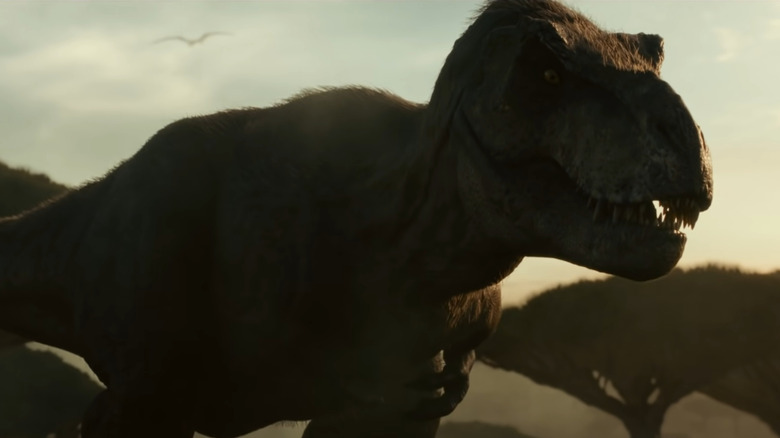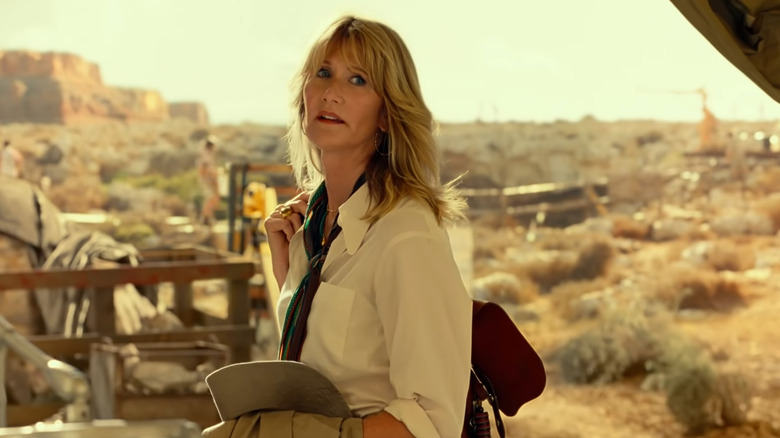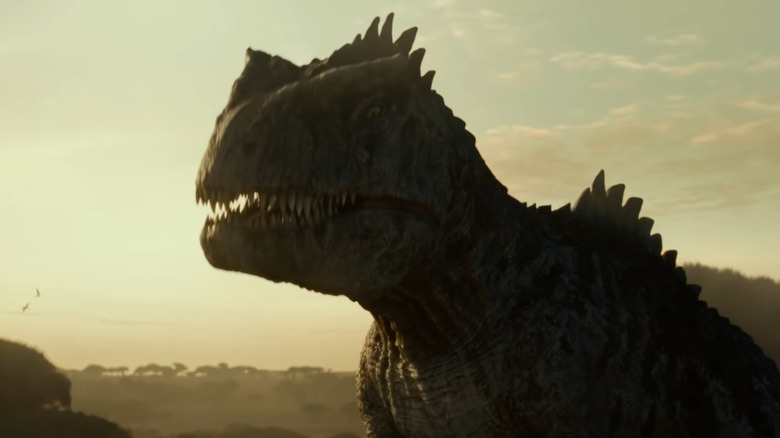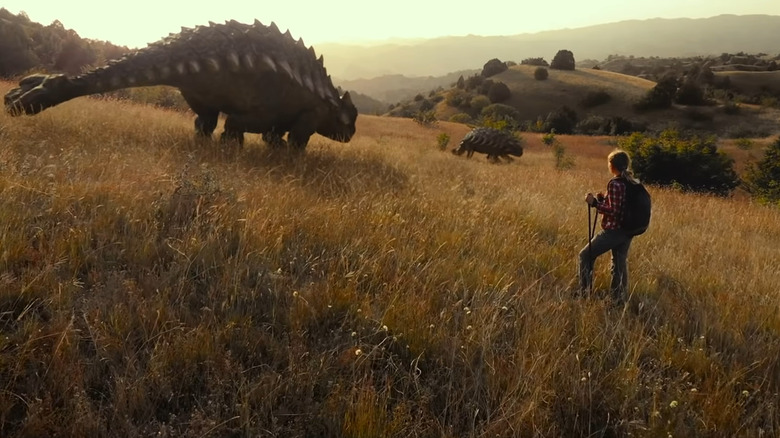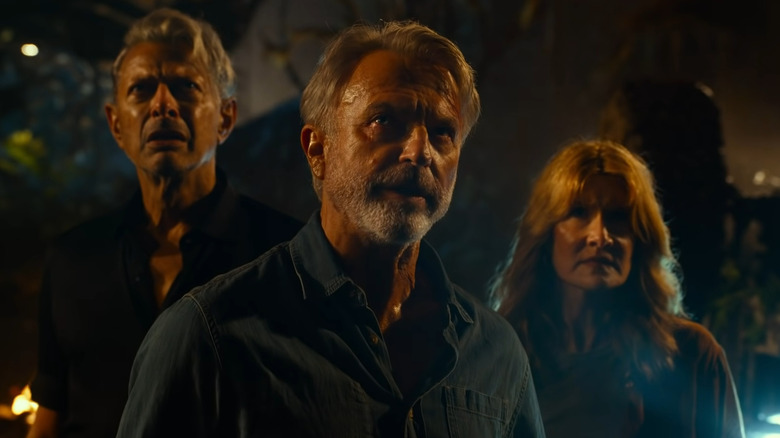The Ending Of Jurassic World: Dominion Explained
Colin Trevorrow's "Jurassic World Dominion" brings the series' reboot trilogy to a close, while also wrapping up some stray plotlines from Steven Spielberg's original dino classic. Newer characters like Owen Grady (Chris Pratt) and Claire Dearing (Bryce Dallas Howard) join forces with the original trio of Dr. Alan Grant (Sam Neill), Dr. Ellie Sattler (Laura Dern), and Dr. Ian Malcolm (Jeff Goldblum). Together, they face off against a new ecological threat sparked by, you guessed it, the actions of yet another corrupt genetics corporation. Dinosaurs abound, planes are crashed, and the fate of the world hangs in the balance.
"Dominion" begins with its large ensemble all scattered to the wind. Owen and Claire have taken to the quiet country life in an effort to protect the genetically cloned Maisie (Isabella Sermon), with occasional departures to keep fighting the fight against illegal dino breeders and poachers. The doctors have each returned to their respective fields of expertise, but they're brought back together by a terrifying environmental development — swarms of massive locusts that threaten to eradicate all life on the planet by obliterating the global food supply. Dr. Sattler has reason to believe that genetics superpower and dinosaur sanctuary proprietor Biosyn is responsible, and she recruits her old friend (surely they're just friends) Alan Grant to help her reveal the truth.
After a series of kidnappings, motorcycle chases, aerial attacks, and lectures on chaos (Malcolm is employed by Biosyn for reasons that are never made fully clear), the whole crew is brought together at the company's dino sanctuary in Italy's Dolomite Mountains. What follows is a dense and cataclysmic climax that attempts to wrap up not only the "Jurassic World" trilogy, but the larger "Jurassic Park" saga as well — but, does it succeed?
The Biosyn plot
The main scheme of Biosyn CEO Lewis Dodgson (Campbell Scott), a character who first appeared in an early scene of "Jurassic Park," seems to be as follows — use his genetically-engineered locusts to restrict the world's food supply, thereby making every country dependent on him and his own locust-immune crops. Unfortunately, the movie doesn't really spend much time explaining this plan. It's mostly revealed through Dr. Sattler's theories, a few vague allusions to "corruption," and one throwaway line from Dodgson talking about how he wants "control."
Dr. Henry Wu (BD Wong), the original lead geneticist at Jurassic Park, is the man responsible for the locusts, and he explains that they actually turned out much stronger than he planned. So it seems that Biosyn's plan was to create a scarcity and a subsequent reliance on their product, but not to such an extreme that global famine was truly on the table. Again, it seems that way, but there's never any real dialogue that confirms Dodgson's plan.
It doesn't help that Dodgson himself is a bit confusing as the film's main villain. At one point, he makes a claim that "money's cheap these days," implying that he's not in the game to get rich. He's already rich, after all. It's reasonable to assume, then — especially given the franchise's past — that his motivations are strictly egotistical; that he wants to feel like a god. But that assessment also doesn't mesh with his presentation in the movie. It's not hard to believe that the eccentric leader of a global technology company is simply evil — power corrupts, after all — but Dodgson's plan seems to lack both a clear intention and an actual blueprint of how to pull it all off.
Henry Wu's redemption
Fortunately for the world, there are numerous agents within the ranks of Biosyn who want nothing more than to stop Dodgson's evil scheme in its tracks. The CEO's direct assistant, Ramsey (Mamoudou Athie), Dr. Ian Malcolm, and Dr. Henry Wu are all secretly working against him, with Wu in particular seeking a deeply-needed redemption.
Wu laments that his locusts are about to bring about the end of human civilization, so he devises a plan to kill them all in a single swift stroke. Maisie, the cloned daughter of Jurassic Park heiress Charlotte Lockwood, possesses the answer within her genes. Her mother fell victim to a rare and deadly genetic disease that ultimately took her life, but after cloning Maisie, Charlotte was able to cure her of the disorder through a technique that, apparently, she never bothered to write down. Wu has Biosyn kidnap Maisie so he can discern Charlotte's method from her genes, which he does in record time.
Despite his many, many past transgressions, the crew decides to help Wu escape from the dinosaur sanctuary so that he can undo the locust plague. A scene during the film's closing montage shows him releasing a sample back into the wild, where it joins with the swarm and, supposedly, brings about their quick demise. "Jurassic World Dominion" doesn't spend much time addressing Wu's other sins, but that may be because the world seems to have accepted the dinosaurs he revived as apart of the new order. Either way, both humans and dinos live to see another day.
A crisis of biblical proportions
Once everything starts to fall apart at the Biosyn sanctuary — Maisie and the young velociraptor Beta escape and Ellie and Alan steal a DNA sample of the engineered locusts — Dodgson decides to call the whole thing and start over. He tries to burn the remaining locusts to remove the evidence of Biosyn's involvement in the famine, but the flying beasts escape and soar over the dino sanctuary, delivering a biblical plague of flaming locusts on the prehistoric world.
It's an undeniably striking addition to the film's climax, as the fiery bugs rain from the sky like it's the end of the world. The whole sequence smacks of the dinosaurs' original extinction event, by design. Fortunately, the dinosaurs themselves don't all die out this time, as they're herded into a protected area to wait out the blaze.
For all its visual appeal, the swarm of flaming locusts doesn't actually end up having that much impact on the story of "Jurassic World Dominion." The dinos continue to live in the Dolomites, Biosyn's sins are still revealed for the world to see, and the apocalypse threatened by the released locusts is still, at least theoretically, averted. But hey, it sure looks cool.
We got Dodgson here!
Lewis Dodgson experiences some big comeuppance for his villainous ways, first in the decimation of his kingdom (which is largely his own fault), and then by a poetical death at the hands of one of the franchise's most iconic dinosaurs.
Once it becomes clear that the situation at the sanctuary isn't fixable, Dodgson prepares for a quick getaway. He asks Ramsey to come with him and claims that they can start over somewhere new, only to discover (in a perhaps unintentionally funny moment that has Ramsey saying not a single word) that his assistant is the one who orchestrated his destruction. Enraged, Dodgson heads out on his own via the facility's train tunnels. For a moment, it looks as if the evil mogul might actual make it out, but a strategic power outage by the film's heroes freezes his train in its tracks. When Dodgson attempts to get out and walk, he's accosted by a squad of Dilophosauruses, who bring his life to an abrupt and violent end.
This death is particularly symbolic, as it's the same fate that befalls Dennis Nedry (Wayne Knight) in the original "Jurassic Park." Dodgson is the one who commissioned Nedry to steal embryos from InGen, so he's also technically the one responsible for the original crisis at the park. There's even a shot in the film of what appears to be Nedry's fake Barbasol can in Dodgson's office — which Dodgson takes with him on the ill-fated escape — implying that, somehow, he managed to locate the site of Nedry's death and bring the embryos back.
A full team effort
Though the early parts of the movie are more akin to globetrotting action flicks like "Fast and Furious," "Jurassic Park Dominion" eventually settles into the series' tried and true formula of stranding all the main characters in the middle of a dinosaur park. Malcolm, Sattler, Grant, Owen, Maisie, Claire, newcomer Kayla Watts (DeWanda Wise) (and eventually, Wu) all meet up in Dolomite sanctuary, where they have to fight for their lives to escape the encroaching beasts. "Dominion" takes advantage of the situation to deliver some cute moments between the different characters, such as Owen telling Grant that he read his book (a reference to the original film) and Claire and Ellie bonding over their respective dino traumas.
This climactic team-up also includes a number of parallels to earlier films in the series. Claire and Ellie have to adjust the sanctuary's power in a dark corridor, reminiscent of the power shed from "Jurassic Park." Dr. Grant brings his decades of velociraptor research to bear in helping Owen and Maisie safely rescue Beta in a moment that, while surely a bit triggering, is also probably pretty cool for the seasoned paleontologist. And of course, Kayla gets the whole crew out safely via helicopter — the only proper way to escape from Jurassic Park.
King stays King
It wouldn't be a "Jurassic Park" movie without some dino-on-dino action, and "Dominion" delivers just that in the form of a climactic duel between the T-rex and the Giganotosaurus. Their battle is foreshadowed earlier in the film, and it finally takes place just as the human crew is about to make their final getaway. As they run for Kayla's chopper, the two primordial behemoths rampage around them, decimating the area and delivering some brutal blows. Just when it looks like the Giganotosaurus has the T-rex dead to rights, though, the humans intervene (for their own reasons) and give the fan-favorite dino a chance at a second wind.
Thanks to the appearance of the long-clawed Therizinosaurus, the T-rex finds a way to win the fight. Channeling all its might, the beast bashes into the Giganotosaurus from the side, knocking him full-on into the Therizinosaurus and impaling it on the other dino's claws. Is it a bit of a cheap victory? Sure. Would the Giganotosaurus have won had the humans not intervened? Probably. But given all the times the T-rex has saved them in previous films, it only seems right that they lend a helping hand in return. There are some facts of the Jurassic world that can never be undone, and one of those is that no matter how big the competition, the T-rex will always reign supreme.
A long-awaited romance
If you came to "Jurassic World Dominion" to see a conclusion to a three-decade-long will-they-won't-they arc between Alan Grant and Ellie Sattler, you're probably in the minority, but you're also in luck. The onscreen chemistry between Sam Neill and Laura Dern remains excellent in "Dominion," and the screenplay spends a good amount of time on their middle-aged romance. Ellie establishes early on that her kids — first shown in "Jurassic Park III" — are grown, and that she's divorced from her former husband. By contrast, Grant has been doing classic Grant things, living a solitary life digging up dinosaur bones.
The circumstances under which these two characters come back together make sense, and the adorably awkward scenes of them navigating their relationship are some of the film's true highlights. It's fun (and not terribly common) to see two characters of their age working through their feelings for each other in the middle of a bombastic action movie, and it's very satisfying to see them finally get together at the end of the story.
The new Jurassic Park
Despite the evils of Biosyn's leader, it seems that the organization has done some legitimately good things in the interest of dinosaur safety and preservation. The biggest example of this, at least by square footage, is the dino sanctuary in the Dolomites, which continues to operate as a refuge for the creatures even after all the terrible events of the film. While some dinosaurs are shown to still be roaming free in other parts of the world in the final sequence, a large number of them are happily relocated to the Dolomites, where they're safe from humans, and where humans are safe from them.
Oddly enough, this is sort of a new Jurassic Park — albeit one that foregoes many of the inherent dangers and problems of the original, and of Jurassic World. In a real-world era when natural preservation and wildlife sanctuaries are becoming highly supported, and in which the sentiment toward for-profit zoos and animal captivity in general has thankfully plummeted, it's interesting to see a dinosaur sanctuary being presented as a sort of "happy ending" for the franchise. John Hammond was a showman, and a businessman, so he probably wouldn't have chosen such an isolated location for the animals he helped revive, but given all that he saw happen as a result of his hubris, it's possible that he would have quite liked the idea of the dinos in the Dolomites.
Peaceful coexistence?
Of course, not every living dinosaur willingly relocates to the sanctuary in Italy at the end of "Jurassic World Dominion." One of the film's most striking sequences comes at the very end — a montage of shots from all across the globe that show how dinosaurs are starting to become part of the modern Earth ecosystem. Pteranodons are shown taking flight alongside ordinary birds. Triceratops roam the blistering savanna alongside herds of elephants. Even the fearsome Mosasaurus swims peacefully alongside whales, who look puny by comparison.
This majestic look at the new world order ends the film on a positive and optimistic note, suggesting that all the perceived dangers of reborn dinosaurs can be managed if humans adopt a perspective of harmony and progress. It's a nice sentiment, and certainly a lovely note to end the film on, but is it realistic?
Consider this: Most of the "Jurassic World" trilogy has been spent building up to this moment of dinosaurs repopulating in the wild. Throughout the entire franchise, it's always been foreshadowed as a dangerous event, and yet "Dominion" seems to brush it off by the end. Most of the film is spent addressing the locust problem, with no real attention paid to the effects the dinos themselves will have. In fact, the world is basically the same at the end of the movie as it is at the very beginning. None of the dino problems have been solved, unless you count a sweetly-worded monologue from a dead scientist as a solution. Surely, planet Earth still has a lot to work out with its new denizens roaming free.
Is the Jurassic Park saga over?
"Experience the epic conclusion of the Jurassic era." That's the tagline that appears in the official trailer for "Jurassic World Dominion," and the film definitely feels like a swan song. From the return of Neill and Dern to the closing scenes of dinos reentering nature, there's a sense that this is meant to be the climactic wrap-up to the entire series. But is it really?
The "Jurassic" franchise has raked in a ton of cash over the decades, and it's become one of Universal's most lucrative brands (per Box Office Mojo). It has not only been a juggernaut for ticket sales, but for merchandising as well. After all, kids will always love dinosaurs. On top of the business reasons to keep the movies going, there are a lot of easy ways to keep the story going. New characters like Kayla and Ramsey are arguably some of the best parts of "Jurassic World Dominion," so even if the franchise's long-time stars are finished, there are plenty of folks who could still return. With dinosaurs now roaming the globe, there are an infinite number of potential storylines to be cooked up to keep the adventure rolling forward.
Whether or not that's actually a good idea from a creative standpoint is another matter entirely. Some might say that the original film should never have become a series in the first place, as most of the subsequent installments have been critically panned. Maybe, like the dinosaurs, "Jurassic Park" shouldn't be brought back to the land of the living. Perhaps, the time has come to let this franchise go extinct.
